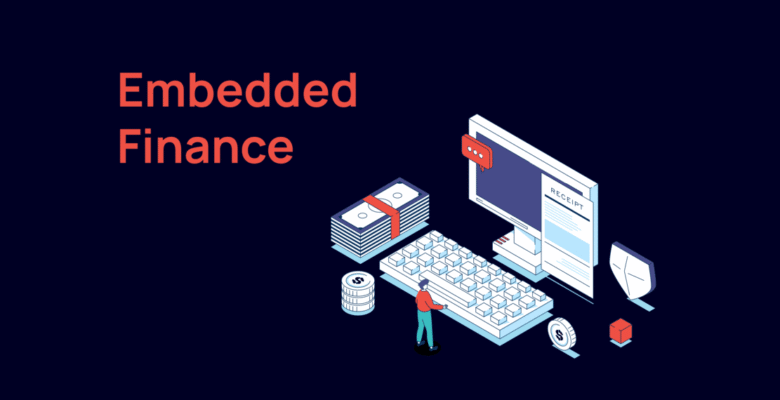Embedded finance is a primary factor driving the rapid changes in how we manage money. This innovative strategy is revolutionizing the delivery of financial services and facilitating their easy accessibility on non-financial platforms. Embedded finance is slowly adding banking capabilities to the digital tools we use every day. For example, car-sharing apps allow drivers to get paid instantly, while online stores offer loans at the checkout. The growth is small but significant, to the point where many people don’t even know they’re using financial services when planning a trip, placing an order, or signing up for a subscription.
As the global digital economy continues to grow, more and more businesses are turning to embedded finance to keep their customers happy, keep them coming back, and find new ways to make money. This article expands on this concept and provides powerful real-world examples of how embedded finance is changing industries. Whether you’re a tech enthusiast, business owner, or consumer, understanding this trend is essential to staying ahead in today’s digitally focused society.
Understanding Embedded Finance and What It Means:
Embedded finance adds financial services to non-financial platforms, allowing businesses to offer services such as payments, loans, insurance, and investment products directly through their apps or websites. Traditionally, only banks and other financial institutions offered these services, but this is changing rapidly. Thanks to innovations in APIs, cloud computing, and fintech, organizations in industries ranging from retail to healthcare to transportation can now offer financial capabilities without becoming banks themselves.
Embedded finance keeps consumers on the platforms they currently use, rather than moving them to third-party financial firms. This approach is not only convenient for users but also offers businesses new ways to drive revenue. It’s a win-win situation driven by convenience, speed, and digital transformation.
Most Common Use Cases for Embedded Payments:
Embedded payments are the most well-known and widely used form of embedded finance. When you order food with a takeaway app, pay for a ride with a taxi app, or pay for a subscription with a streaming service with a single click, you’re using embedded payments. These frictionless transactions are made possible by behind-the-scenes partnerships between platforms and payment service providers like Stripe, PayPal, and Square.
The goal is to eliminate friction. Users no longer have to enter their card details for every transaction. Instead, the app or website processes the payment instantly and securely. This streamlined process can lead to increased sales, happier customers, and fewer abandoned carts, crucial criteria for any online business.
Buy Now, Pay Later Is a Popular Choice Among Consumers:
Another way embedded finance is revolutionizing the market is through Pay Now, Pay Later (BNPL). These options allow customers to split their purchases into smaller payments with local interest rates. Klarna, Afterpay, and Affirm are just a few of the notable companies that are partnering with e-commerce sites to offer financing options at checkout.
This gives customers more freedom without having to apply for a credit card or wait for a long approval process. For businesses, Pay Now, Pay Later means higher average order sizes and fewer abandoned carts. The impact of BNPL is changing the way people shop and budget, especially younger people who prefer digital financial tools. This applies to everything from fashion stores to electronics stores.
Embedded Insurance: Direct Protection for the Service
Embedded insurance is another fast-growing sector that offers direct protection during the transaction process. For instance, you frequently encounter the option to add insurance during the checkout process when renting a car, booking a flight, or purchasing a smartphone online. These offers are product- or service-specific and part of the purchase process.
When you book a trip on a travel website like Expedia or a ride-sharing site like Uber, you can also purchase travel or driver insurance. When you add a device to your cart, a store can offer protection against theft or loss. This direct solution can boost conversion rates, generate an additional revenue stream, and provide consumers with a sense of peace of mind.
Embedded Banking: From Brands to Financial Centers
Embedded banking is a more advanced form of embedded finance. Instead of just offering loans or payment services, companies offer full banking services, including checking accounts, debit cards, and even savings options. For example, Shopify offers integrated financial tools like Shopify Balance to its merchants, allowing them to process sales, fees, and expenses directly on the website.
Companies like Uber and Lyft offer driver accounts that allow drivers to get paid directly without having to go through the regular banking process. Back-end fintech providers, or Banking as a Service (BaaS) platforms, support these banking functions, allowing non-banking institutions to act as financial service centers. Such an arrangement allows companies to build stronger relationships with their customers and capture a larger share of their customer base.
The Future of Embedded Finance in Every Industry:
Embedded money is shaking up entire industries, not just e-commerce and transportation. Patients can now get financing options during their doctor’s visits to cover expensive medical bills. In real estate, platforms allow users to pay a down payment or purchase rental insurance immediately upon signing a lease. Even schools are finding ways to help students pay their tuition as part of the admissions process.
As technology advances and regulations are refined, the embedded finance model will continue to expand into new areas. More and more companies will become fintechs, offering highly integrated financial services that users barely notice they’re using. The finance layer has become less known but more powerful than ever.
Conclusion:
The magic of embedded finance lies in its intangibility. It allows financial tools to fade into the background while creating tremendous value for individuals and businesses. In a world focused on speed, convenience, and customization, providing a seamless financial experience is no longer optional but a must-have for businesses. Embedded finance is changing the way we think about money. From paying for groceries with a single tap to buying a new laptop in installments to purchasing insurance right at the checkout.
As the digital economy evolves, more and more platforms will adopt these technologies, making it harder to distinguish between traditional banking and everyday services. This shift presents a huge opportunity for businesses to come up with new ideas that benefit customers and for technology to move financial processes to the backend so they work better, faster, and smarter.
FAQs:
1. What is a simple definition of embedded finance?
Embedded finance is when financial services such as payments, loans, or insurance are integrated into non-financial apps or platforms so that customers can use them without leaving the platform.
2. How does embedded finance help businesses?
Integrated financial services enable businesses to provide a seamless customer experience, attract repeat customers, increase revenue, and find new ways to make money.
3. What are some common uses of embedded finance?
You can pay for Uber rides in the app, use the “buy now, pay later” service at online checkout, or purchase travel insurance when booking a flight.
4. Are embedded finance solutions replacing the role of banks?
Not really. They work with banks and fintechs to use APIs and platforms to make services easier to use in digital experiences.
5. Is embedded finance safe for people?
Yes, most embedded finance solutions use encrypted, PCI-compliant technology and work with trusted fintech partners to ensure the security of transactions and profiles.




